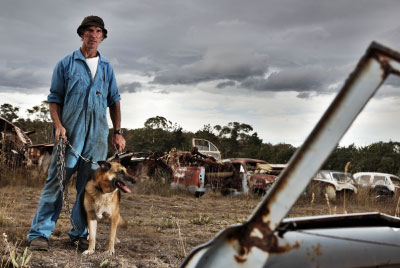Just West of Cooma, gateway to the Snowy Mountains on the NSW-Victoria border, there lies a spectacular monument. Literally thousands of terracotta-coloured statues stand silent, in ordered rows, recalling in their own way the 100,000 men who spent a quarter of a century constructing Australia’s engineering wonder, the Snowy Mountains Scheme.
Okay, so it’s not exactly the entombed warriors of Xi’an. But with more than 3500 cars, around two-thirds of them from 40 to 70 years old, lined up on a rolling hillside of eight hectares, Flynn’s Wrecking Yard was once named by an American classic-car magazine as one of the 10 best automotive junkyards in the world.By freakish dint of its age, history, location and climate, this rustic rust-o-rama is more like an open-air museum of oxidising automobilia.The collection of crippled – very rarely crumpled – cars is largely comprised of American, British, European and Australian models from the 1930s through to the ’60s. Many are rare to see in any condition. But to see DeSotos, Dodges, Vanguards and Simcas so remarkably whole, frozen in the geologically slow process of merging back into earth and fungus and sunshine, borders on a poetic experience.It’s presided over by a junkyard dog straight from central casting; a heavily-chained German Shepherd named Sheba that lives behind a bricked-up Ford F-Series ambulance.“Sheba, she’s a good dog,” drawls Wayne Flynn, 51, who took over the yard some years ago from his father, Jim. “She’s gettin’ a bit old, but she keeps people at bay. Occasionally we find a few sandshoes near the fence, so she’s doin’ a good job!”Flynn is the one-man band who also does mechanical servicing and flogs the odd, cheap used car from the dirt lot in front of the office. And very occasionally, someone will buy one of the “oldies” from the cemetery-like rows down the back. “The ’37 DeSoto down there, a bloke’s just put a deposit on it,” he says.These days, few customers come in looking for Mercury manifolds or Studebaker steering gear. But in the past eight or so years, more and more have been coming just to look.“What I do is, I charge ’em ten bucks to wander through, and then they get the selection of a [greeting] card when they come up,” Wayne grins. “Some people go, ‘I’m not paying ten bucks to look at heaps of shit!’ But there are other people who walk down two rows and yell out, ‘I’ve already got me ten bucks’ worth!'”The extraordinary birth and growth of the yard founded by Jim Flynn in 1955 is entwined with that of the Snowy Mountains Scheme, and of Australia herself. Initiated in 1949, the hydro-electricity and irrigation scheme was one of the world’s (and remains as Australia’s) largest civil-engineering projects.In its 25 years of construction, it employed more than 100,000 people – around 7000 at any one time – of whom some 70 percent were migrants from war-ravaged countries across Europe. They would be instrumental in changing Australia’s cultural and automotive complexion.Jim Flynn delivered their mail. Fitting chains in winter, he drove the Postmaster General’s split-window VW Kombi all over the treacherous Snowy Mountains slopes, and in his spare time played saxophone in a jazz band.One night in the early 1950s, Flynn was driving home from a country dance with fellow band-members in a 1950 Dodge. He’d agreed to sell the car earlier that day. Entering the historic, 1889 iron-lattice bridge at Dalgety, the Dodge slithered on the ice-covered timber roadway. It toppled into the shallow Snowy River some three metres below.Flynn found himself with a broken collarbone, and others in the car with various breaks and bruises. And a destroyed Dodge. He set about dismantling the Dodge to recoup money from parts. Soon someone offered him another wreck, and another. Eventually he bought this land four kilometres west of Cooma and opened the wrecking yard.In the automotive context, the Snowy Mountains Scheme is best remembered for the introduction of Land Rover to Australia – well over 200 were sold in the project’s first four years – and later (in 1959), of Toyota, with the LandCruiser.But the majority of Snowy workers lived a very different motoring reality. A 10- or 15-year-old used car meant one from the 1940s or ’30s. The scarcity of cars during WW2 ensured that most of that vintage had been kept running. The ones favoured by workers for the long, rough roads were the big, simple, plush-riding Americans.Usually, there’d be four owners. Snowy workers typically lived in two-bed tents or cabins; day-shift and night-shift workers would literally take shifts to sleep. And they’d likewise take two-up turns in the car, shuttling to their shifts.“What happened a lot was that the cars wouldn’t have had any road damage, but the gearbox might have chucked it in,” Wayne says. “They couldn’t afford to wait a week or two for repairs, so they’d ring dad and say there’s a car here for ya, come and grab it and give us some money. Then they’d just get another car from one of the garages around here to keep ’em going for the next 12 months.”Father Jim, now in his 80s, had quite the nose for business. Around 1962, he opened a new dealership for Nissan, whose Patrol had been introduced seven years earlier. In 1968, he added Toyota, whose reputation was being built among the Snowy workers but was much slower to spread elsewhere.“They used to give [dad] a hard time – the Japs weren’t real popular in those days,” Wayne smiles. “They were good vehicles, but he used to get a lot of flak from people who had uncles they’d lost during the war, that sort of stuff.”The new-car business was wound up in the early 1980s. The fact that it also handled Honda could explain the tiny Zots among the three- to four-dozen ’60s-’70s Crowns, Corona MkIIs, and Tiaras in the front yard. It also explains Jim’s apparently long run of Datsun 180B bush-speedway cars.But it’s the back two-thirds of the yard that draws the odd overseas phone call and a steady trickle of sightseers. The cars are arranged back-to-back in rows, surprisingly well ordered by marque and nationality.Gaps in some of the rows reinforce the yard’s graveyard feel. Often, the location of these vacant plots suggests ‘runs’ on particular cars, like XW-XY Falcons or hatchback Toranas, two examples notable by their absence. The grass is kept pretty well in check by a local mower man named Lou. This I learn when I ask Wayne, “Where’s the loo?” and he replies, “There, on the mower”.Most of the cars aren’t on their wheels, nor are many crashed. A few are slowly collapsing. A Cortina Mk1 is being reclaimed by the earth, slumping over its wheels as it rusts from the sills up. It’s interesting to note how badly it is decomposing compared with many of the 1930s Hudson, Buick, Chevrolet and Oldsmobile ‘gangster cars’ a couple of rows away.Still, the Cortina’s chromed bumpers shine optimistically. The same is true of the chromework on a lot of the old cars, including a proud, picket-fence row of 48-215 Holdens. “The climate has kept it that way, and the chrome was well-made in those days,” Wayne tells me. I’ve watched cars being born, seen others end violently. But strolling through the yard among these shapes that were so familiar, yet so hugely transformed – like a digitally-modified image of Marilyn Monroe at age 82 – got me very much in touch with my appreciation of cars as art.Prejudices against certain cars as going concerns melted away when I regarded them in repose.I was transfixed by the C-pillar treatment and impossibly elegant rear door handle of a PA Vauxhall Velox, a car easily dismissed as just another Pommy shitter. Ford Mainline utes show off their almost art deco swage lines. I was arrested by the Noddy-car cuteness of the Lloyd-Hartnett.A rust-over-green Ford Anglia 100E with terrified eyes and grimacing grille is a motoring mockery of Edvard Munch’s painting, The Scream. Likewise, a smashed and semi-slumped Simca Aronde – my father used to race one of these – wears the murderer’s mask from the Scream horror-film franchise.A couple of Land Rovers camouflage their naked panels among the misty ghost gums. And nature is applying herself in artistic ways: the perfect starburst rust-pattern that radiates from the roof of a Renault Dauphine; a tree that has literally grown through the chassis of a pick-up truck; moss and mildew embracing and embellishing badgework and bonnet contours.This literally had been Wayne Flynn’s playground as a child. If I got this emotional about these wrecks, whose lives ended not with a bang but with a century-long whimper, how must it be for him? Were there cars that he remembered being towed-in, cars in which he played, and into which he might still sneak away for a deep, contemplative moment?“Nah,” he shrugs. “What I mostly remember is that me and the other kids used to jump across the roofs and dent them in! Dad didn’t enjoy it much.“But it’s more the car going out the door,” he says. When you sell something, you realise, that’s it – she’s not coming back. Hopefully it’ll drive back at some stage. That gives you a real kick.“I’d love to see that DeSoto come back.”





